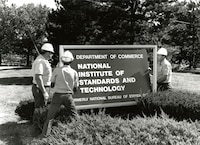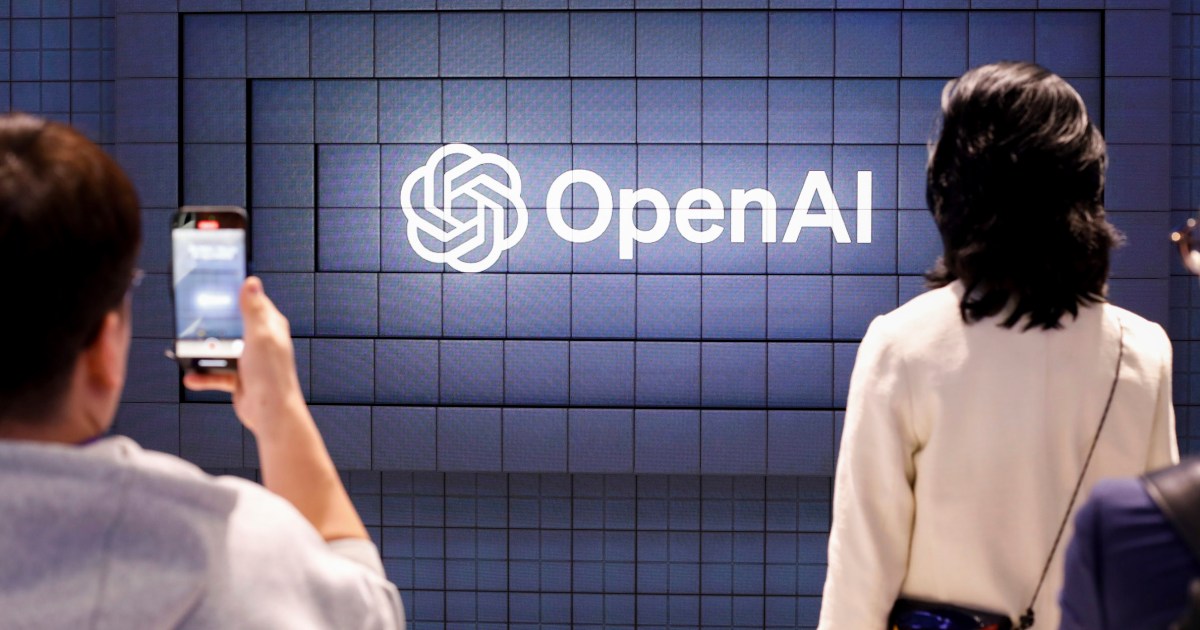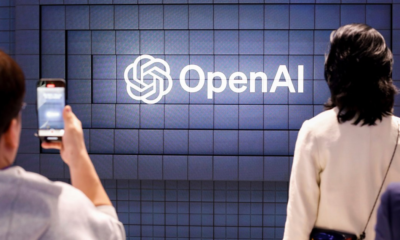Tech News
NIST, the lab at the center of Biden’s AI safety push, is decaying – The Washington Post

At the National Institute of Standards and Technology — the government lab overseeing the most anticipated technology on the planet — black mold has forced some workers out of their offices. Researchers sleep in their labs to protect their work during frequent blackouts. Some employees have to carry hard drives to other buildings; flaky internet won’t allow for the sending of large files.
And a leaky roof forces others to break out plastic sheeting.
“If we knew rain was coming, we’d tarp up the microscope,” said James Fekete, who served as chief of NIST’s applied chemicals and materials division until 2018. “It leaked enough that we were prepared.”
NIST is at the heart of President Biden’s ambitious plans to oversee a new generation of artificial intelligence models; the agency is tasked with developing tests for security flaws and other harms. But budget constraints have left the 123-year-old lab with a skeletal staff on key tech teams and most facilities on its main Gaithersburg, Md., and Boulder, Colo., campuses below acceptable building standards.
Interviews with more than a dozen current and former NIST employees, Biden administration officials, congressional aides and tech company executives, along with reports commissioned by the government, detail a massive resources gap between NIST and the tech firms it is tasked with evaluating — a discrepancy some say risks undermining the White House’s ambitious plans to set guardrails for the burgeoning technology. Many of the people spoke to The Washington Post on the condition of anonymity because they were not authorized to speak to the media.
Even as it races to set up the new U.S. AI Safety Institute, the crisis at the degrading lab is becoming more acute. On Sunday, lawmakers released a new spending plan that would cut NIST’s overall budget by more than 10 percent, to $1.46 billion. While lawmakers propose to invest $10 million in the new AI institute, that’s a fraction of the tens of billions of dollars tech giants like Google and Microsoft are pouring into the race to develop artificial intelligence. It pales in comparison to Britain, which has invested more than $125 million into its AI safety efforts.
The cuts to the agency “are a self-inflicted wound in the global tech race,” said Divyansh Kaushik, the associate director for emerging technologies and national security at the Federation of American Scientists.
Some in the AI community worry that underfunding NIST makes it vulnerable to industry influence. Tech companies are chipping in for the expensive computing infrastructure that will allow the institute to examine AI models. Amazon announced that it would donate $5 million in compute credits. Microsoft, a key investor in OpenAI, will provide engineering teams along with computing resources. (Amazon founder Jeff Bezos owns The Post.)
Tech executives, including OpenAI CEO Sam Altman, are regularly in communication with officials at the Commerce Department about the agency’s AI work. OpenAI has lobbied NIST on artificial intelligence issues, according to federal disclosures. NIST asked TechNet — an industry trade group whose members include OpenAI, Google and other major tech companies — if its member companies can advise the AI Safety Institute.
NIST is also seeking feedback from academics and civil society groups on its AI work. The agency has a long history of working with a variety of stakeholders to gather input on technologies, Commerce Department spokesman Charlie Andrews said.
AI staff will be working in well-equipped offices in the Gaithersburg campus, the Commerce Department’s D.C. office and the NIST National Cybersecurity Center of Excellence in Rockville, Md, Andrews said.
White House spokeswoman Robyn Patterson said the appointment of Elizabeth Kelly to the helm of the new AI Safety Institute underscores the White House’s “commitment to getting this work done right and on time.” Kelly previously served as special assistant to the president for economic policy.
“The Biden-Harris administration has so far met every single milestone outlined by the president’s landmark executive order,” Patterson said. “We are confident in our ability to continue to effectively and expeditiously meet the milestones and directives set forth by President Biden to protect Americans from the potential risks of AI systems while catalyzing innovation in AI and beyond.”
NIST’s financial struggles highlight the limitations of the administration’s plan to regulate AI exclusively through the executive branch. Without an act of Congress, there is no new funding for initiatives like the AI Safety Institute and the programs could be easily overturned by the next president. And as the presidential elections approach, the prospects of Congress moving on AI in 2024 are growing dim.
Congressional aides and former NIST employees say the agency has not been able to break through as a funding priority — even as lawmakers increasingly tout its role in addressing technological developments, including AI, chips and quantum.
A review of NIST’s safety practices in August found that the budgetary issues endanger employees, alleging the agency has an “incomplete and superficial approach” to safety.
“Chronic underfunding of the NIST facilities and maintenance budget has created unsafe work conditions and further fueled the impression among researchers that safety is not a priority,” said the NIST safety commission report, which was commissioned following the 2022 death of an engineering technician at the agency’s fire research lab.
NIST is one of the federal government’s oldest science agencies — with one of the smallest budgets. Initially called the National Bureau of Standards, it began at the dawn of the 20th century, as Congress realized the need to develop more standardized measurements amid the expansion of electricity, the steam engine and railways.
The need for such an agency was underscored three years after its founding, when fires ravaged through Baltimore. Firefighters from Washington, Philadelphia and even New York rushed to help put out the flames, but without standard couplings, their hoses couldn’t connect to the Baltimore hydrants. The firefighters watched as the flames overtook more than 70 city blocks in 30 hours.
NIST developed a standard fitting, unifying more than 600 different types of hose couplings deployed across the country at the time.
Ever since, the agency has played a critical role in using research and science to help the country learn from catastrophes and prevent new ones. Its work expanded after World War II: It developed an early version of the digital computer, crucial Space Race instruments and atomic clocks, which underpin GPS. In the 1950s and 1960s, the agency moved to new campuses in Boulder and Gaithersburg after its early headquarters in Washington fell into disrepair.
Now, scientists at NIST joke that they work at the most advanced labs in the world — in the 1960s. Former employees describe cutting-edge scientific equipment surrounded by decades-old buildings that make it impossible to control the temperature or humidity to conduct critical experiments.
“You see dust everywhere because the windows don’t seal,” former acting NIST director Kent Rochford said. “You see a bucket catching drips from a leak in the roof. You see Home Depot dehumidifiers or portable AC units all over the place.”
The flooding was so bad that Rochford said he once requested money for scuba gear. That request was denied, but he did receive funding for an emergency kit that included squeegees to clean up water.
Pests and wildlife have at times infiltrated its campuses, including an incident where a garter snake entered a Boulder building.
More than 60 percent of NIST facilities do not meet federal standards for acceptable building conditions, according to a February 2023 report commissioned by Congress from the National Academies of Sciences, Engineering and Medicine. The poor conditions impact employee output. Workarounds and do-it-yourself repairs reduce the productivity of research staff by up to 40 percent, according to the committee’s interviews with employees during a laboratory visit.
Years after Rochford’s 2018 departure, NIST employees are still deploying similar MacGyver-style workarounds. Each year between October and March, low humidity in one lab creates a static charge making it impossible to operate an instrument ensuring companies meet environmental standards for greenhouse gases.
Problems with the HVAC and specialized lights have made the agency unable to meet demand for reference materials, which manufacturers use to check whether their measurements are accurate in products like baby formula.
Facility problems have also delayed critical work on biometrics, including evaluations of facial recognition systems used by the FBI and other law enforcement agencies. The data center in the 1966 building that houses that work receives inadequate cooling, and employees there spend about 30 percent of their time trying to mitigate problems with the lab, according to the academies’ reports. Scheduled outages are required to maintain the data centers that hold technology work, knocking all biometric evaluations offline for a month each year.
Fekete, the scientist who recalled covering the microscope, said his team’s device never completely stopped working due to rain water.
But other NIST employees haven’t been so lucky. Leaks and floods destroyed an electron microscope worth $2.5 million used for semiconductor research, and permanently damaged an advanced scale called a Kibble balance. The tool was out of commission for nearly five years.
Despite these constraints, NIST has built a reputation as a natural interrogator of swiftly advancing AI systems.
In 2019, the agency released a landmark study confirming facial recognition systems misidentify people of color more often than White people, casting scrutiny on the technology’s popularity among law enforcement. Due to personnel constraints, only a handful of people worked on that project.
Four years later, NIST released early guidelines around AI, cementing its reputation as a government leader on the technology. To develop the framework, the agency connected with leaders in industry, civil society and other groups, earning a strong reputation among numerous parties as lawmakers began to grapple with the swiftly evolving technology.
The work made NIST a natural home for the Biden administration’s AI red-teaming efforts and the AI Safety Institute, which were formalized in the November executive order. Vice President Harris touted the institute at the U.K. AI Safety Summit in November. More than 200 civil society organizations, academics and companies — including OpenAI and Google — have signed on to participate in a consortium within the institute.
OpenAI spokeswoman Kayla Wood said in a statement that the company supports NIST’s work, and that the company plans to continue to work with the lab to “support the development of effective AI oversight measures.”
Under the executive order, NIST has a laundry list of initiatives that it needs to complete by this summer, including publishing guidelines for how to red-team AI models and launching an initiative to guide evaluating AI capabilities. In a December speech at the machine learning conference NeurIPS, the agency’s chief AI adviser, Elham Tabassi, said this would be an “almost impossible deadline.”
“It is a hard problem,” said Tabassi, who was recently named the chief technology officer of the AI Safety Institute. “We don’t know quite how to evaluate AI.”
The NIST staff has worked “tirelessly” to complete the work it is assigned by the AI executive order, said Andrews, the Commerce spokesperson.
“While the administration has been clear that additional resources will be required to fully address all of the issues posed by AI in the long term, NIST has been effectively carrying out its responsibilities under the [executive order] and is prepared to continue to lead on AI-related research and other work,” he said.
Commerce Secretary Gina Raimondo asked Congress to allocate $10 million for the AI Safety Institute during an event at the Atlantic Council in January. The Biden administration also requested more funding for NIST facilities, including $262 million for safety, maintenance and repairs. Congressional appropriators responded by cutting NIST’s facilities budget.
The administration’s ask falls far below the recommendations of the national academies’ study, which urged Congress to provide $300 to $400 million in additional annual funding over 12 years to overcome a backlog of facilities damage. The report also calls for $120 million to $150 million per year for the same period to “stabilize the effects of further deterioration and obsolescence.”
Ross B. Corotis, who chaired the academies committee that produced the facilities report, said Congress needs to ensure that NIST is funded because it is the “go-to lab” when any new technology emerges, whether that’s chips or AI.
“Unless you’re going to build a whole new laboratory for some particular issue, you’re going to turn first to NIST,” Corotis said. “And NIST needs to be ready for that.”
Eva Dou and Nitasha Tiku contributed to this report.
Tech News
Senators to seek billions for AI research, push for regulation – The Washington Post

Crafted by a bipartisan group of senators, the plan reviews a host of issues — including AI’s effect on the military, health care and workers. It could be released as soon as Tuesday.
A bipartisan group of senators, including Majority Leader Charles E. Schumer, will unveil a long-awaited “road map” this week for regulating artificial intelligence, directing Congress to infuse billions of dollars into research and development of the technology while addressing its potential harms.
The sprawling directive comes almost a year after Schumer (D-N.Y.) called for an “all hands on deck” push to regulate AI, saying Congress needed to accomplish years of work in months.
Tech News
Postdoctoral fellows grow research at Virginia Tech – Virginia Tech

Two new postdoctoral fellows in the Department of Computer Science have joined the growing ranks of independent scholars contributing to the discipline while growing their nascent careers.
13 May 2024
The Department of Computer Science recently added its first two Presidential Postdoctoral Fellows, JinYi Yoon and Adithya Kulkarni.
They join the ranks of more than 200 postdoctoral scholars working across every Virginia Tech college and institute to advance the pursuit of knowledge and develop into the next generation of experts in their fields.
In 2022, to support the capacity of postdoctoral fellows to initiate innovative and exciting projects, the university established the Office of Postdoctoral Affairs to serve this important community.
“Our office sees our mission as supporting postdoctoral scholars through program and resource sharing so they can develop the skills and confidence they need to excel as researchers and also go out and serve the world in whatever career they choose, post-postdoc,” said Chris Smith, postdoctoral affairs program administrator.
That same year, the competitive Presidential Postdoctoral Fellowship was established. It seeks to strengthen the university’s ability to recruit outstanding, diverse postdoctoral associates by offering up to two years of salary and benefits, $10,000 for training and professional development, as well as formal mentoring. The fellowship is offered twice a year.
Yoon and Kulkarni talked about their work and their hopes for the program
Please explain what a postdoctoral fellow is and what you’ll be doing for the department and the university. Why did you choose Virginia Tech for your postdoctoral work?
A postdoctoral fellow is a researcher who holds a doctoral degree and is involved in advanced research. My primary goal is to contribute to Virginia Tech through conducting high-quality research. Additionally, I aim to share my experience by mentoring graduate students and participating in grant writing initiatives. I aspire to nurture long-term collaborations for sustained research projects and draw diverse international researchers to the university.
Virginia Tech offers an ideal environment for my research interests due to its strong faculty expertise, research centers, and industry collaborations. These centers facilitate potential collaborations with artificial intelligence (AI) experts, while the university’s partnerships with industries perfectly align with my research focus on edge intelligence and intelligent network systems.
Also, I am working with Bo Ji, and his work in machine learning (ML), networking, security/privacy, and mixed reality, particularly in edge intelligence, aligns well with my research objectives. His mentorship, conference organization, academic networking, grant pursuit, and curriculum development opportunities are essential for my future career as an educator, and I anticipate collaborating with other mentors and fellows to enhance our collective efforts. In addition to that, I really like Blacksburg.
What are you hoping to accomplish with your postdoctoral research?
Certainly, the most important focus is to conduct high-quality research in collaboration with Virginia Tech. My research interests are centered around machine learning-driven networked systems, particularly in the domains of edge intelligence and federated/split learning. Edge intelligence, also known as edge AI, refers to AI on edge devices such as smartphones or other devices located close to where data is generated, often near the user.
Although this area is both timely and captivating, it necessitates an understanding of both networking and AI concepts. While I currently align more closely with networked systems researchers, I aim to use my time at the university to develop into a proficient ML-driven networked systems researcher. I am deeply committed to becoming a researcher and educator, and this fellowship presents an invaluable opportunity to advance toward these goals, contributing to the ongoing research endeavors at Virginia Tech. I am very excited about collaborating with fellow postdoctoral researchers across diverse fields of study with the guidance of respected mentors, and this collaboration sets the stage for sustained research projects.
What advice do you have for students interested in becoming a postdoctoral fellow?
It’s quite a challenging question, as this is my first postdoc position. So far, I’ve come to realize that it is important to clarify long-term career goals and research interests. While it is possible to explore a wide range of research areas, as a postdoc and independent researcher, having a specific — yet flexible — focus can be advantageous. This does not mean doing the same things as before; instead, I want to emphasize the need to broaden your research experience without losing sight of your unique perspective.
Although it may be difficult to find a university or research institution that aligns with your research interests, once you secure a position, I believe the postdoc experience becomes invaluable for building professional relationships with fellow researchers and peers in your field, extending beyond the scope of your Ph.D. studies.
Please explain what a postdoctoral fellow is and what you’ll be doing for the department and the university.
The postdoctoral fellowship is a research-oriented position to train me for the next steps in my career and help me grow as a researcher, mentor, and lecturer. As a postdoctoral fellow, I will be combining the power of graph learning and large language models (LLMs) to develop approaches that enable explainability, interpretability, replicability, and, thus, the general robustness of LLMs. Furthermore, I will be mentoring graduate students working with my advisors Dr. Dawei Zhou and Dr. Lifu Huang. I plan to teach introductory computer science courses at Virginia Tech.
Why did you choose Virginia Tech for your postdoctoral work?
I adore the research work conducted by my advisors, Dawei Zhou and Lifu Huang. With their mentorship and guidance, I want to strengthen my research capabilities and increase the scope of my research. Furthermore, I learned about the exceptional training and support the Office of Postdoctoral Affairs provides to help postdocs grow professionally. I also wanted to be part of the vibrant community at Virginia Tech.
What are you hoping to accomplish with your postdoctoral research?
With my research, I plan to address hallucination issues faced by LLMs and overcome the requirement of labeled data for training LLMs. My research will apply to many domains, such as e-commerce, biomedicine, social networks, and natural language processing in general. Within computer science research, my work will drive research forward toward LLM explainability, interpretability, and general robustness. My postdoctoral research will continuously generate research papers, workshops, and tutorials on natural language processing, AI, data mining, and machine learning conferences.
What advice do you have for students interested in becoming a postdoctoral fellow?
A postdoctoral fellowship will help you strengthen your understanding of the research in your field of study and help you grow as a researcher and mentor. You will learn to become an independent researcher and gain mentorship experience, which will be pivotal to having a successful career both as a research faculty or as a researcher in a corporate setting. The experience of your advisors will help you gain exposure to research, grant writing, and teaching courses, which are seldom learned during a Ph.D. Virginia Tech has exceptional postdoctoral training and support, and I suggest becoming a postdoctoral fellow to grow professionally.
Written by Tayler Butters, a senior English major in the College of Liberal Arts and Human Sciences
Chelsea Seeber
540-231-2108
Virginia Tech demonstrates impact as a global land grant – progressing sustainability in our community, through the Commonwealth of Virginia, and around the world.
Get Directions
See All Locations
Contact Virginia Tech
For the media
© 2024 Virginia Polytechnic Institute and State University. All rights reserved.
Tech News
OpenAI’s newest AI model can hold a humanlike conversation – NBC News

Profile
Sections
tv
Featured
More From NBC
Follow NBC News
There are no new alerts at this time
OpenAI has introduced its most comprehensive artificial intelligence endeavor yet: a multimodal model that will be able to communicate to users through both text and voice.
GPT-4o, which will be rolling out in ChatGPT as well as in the API over the next few weeks, is also able to recognize objects and images in real time, the company said Monday.
The model synthesizes a slew of AI capabilities that are already separately available in various other OpenAI models. But by combining all these modalities, OpenAI’s latest model is expected to process any combination of text, audio and visual inputs more efficiently.
Users can relay visuals — through their phone camera, by uploading documents, or by sharing their screen — all while conversing with the AI model as if they are in a video call. The technology will be available for free, the company announced, but paid users will have five times the capacity limit.
OpenAI, which is backed by Microsoft, also announced a new desktop app for ChatGPT, its popular chatbot first launched in 2022, on MacOS.
Mira Murati, chief technology officer at OpenAI, said during a livestream demonstration that making advanced AI tools available to users for free is a “very important” component of the company’s mission.
“This is the first time that we are really making a huge step forward when it comes to the ease of use. And this is incredibly important because we’re looking at the future of interaction between ourselves and the machines,” Murati said. “And we think that GPT-4o is really shifting that paradigm into the future of collaboration where this interaction becomes much more natural and far, far easier.”
Team members demonstrated the new model’s audio capabilities during the livestream, and shared clips to social media.
An AI assistant that can reason in real time using vision, text and voice would enable the technology to perform a creative range of tasks — such as walking users through a math problem, translating languages during a conversation and reading human facial expressions.
GPT-4o’s response time is much faster than previous models, Murati said in the livestream. The model significantly improves the quality and speed of its performance in 50 different languages.
It matches GPT-4 Turbo, its latest generation model before GPT-4o, in English and code abilities, according to an OpenAI blog post about the news.
It also surpasses existing OpenAI models in vision and audio understanding, the company wrote. CEO Sam Altman wrote in his own blog post Monday that GPT-4o’s new voice and video features are the “best compute interface [he’s] ever used.”
“It feels like AI from the movies; and it’s still a bit surprising to me that it’s real. Getting to human-level response times and expressiveness turns out to be a big change,” Altman wrote. “The original ChatGPT showed a hint of what was possible with language interfaces; this new thing feels viscerally different. It is fast, smart, fun, natural, and helpful.”
Voice capabilities in ChatGPT are not new — the model has offered users a conversational voice assistant since last fall. But unlike its existing voice mode, Murati said, GPT-4o’s voice feature reacts in real time, getting rid of the two- or three-second lag to emulate human response times.
And unlike in ChatGPT’s previous voice mode, a conversation with GPT-4o can keep flowing even if users interrupt it mid-response. During Monday’s demonstration, Mark Chen, head of frontiers research at OpenAI, revealed that GPT-4o can read the user’s tone of voice while also generating a variety of emotion in its own voice.
This new model comes on the heels of the company’s latest — still unreleased — text-to-video model Sora, which made waves in tech and entertainment circles in recent months after it was unveiled in February.
OpenAI’s announcement also rolled out just a day before Google’s annual I/O developer conference, scheduled for Tuesday, where the tech giant is expected to give updates on its latest AI-related developments as well.
In 2023, a record $29.1 billion was invested across nearly 700 generative AI deals, CNBC reported.
Angela Yang is a culture and trends reporter for NBC News.
© 2024 NBC UNIVERSAL
-

 General Knowledge2 years ago
General Knowledge2 years agoList of Indian States and Capital
-

 General Knowledge2 years ago
General Knowledge2 years agoList Of 400 Famous Books and Authors
-

 Important Days4 years ago
Important Days4 years agoImportant Days of Each Month
-

 General Knowledge2 years ago
General Knowledge2 years agoCountries and their National Sports
-

 General Knowledge3 years ago
General Knowledge3 years agoCountry Capital and Currency
-

 Important Days3 years ago
Important Days3 years agoHoli
-

 General Knowledge2 years ago
General Knowledge2 years agoList of Indian President
-

 General Knowledge2 years ago
General Knowledge2 years agoList of Indian Vice President












